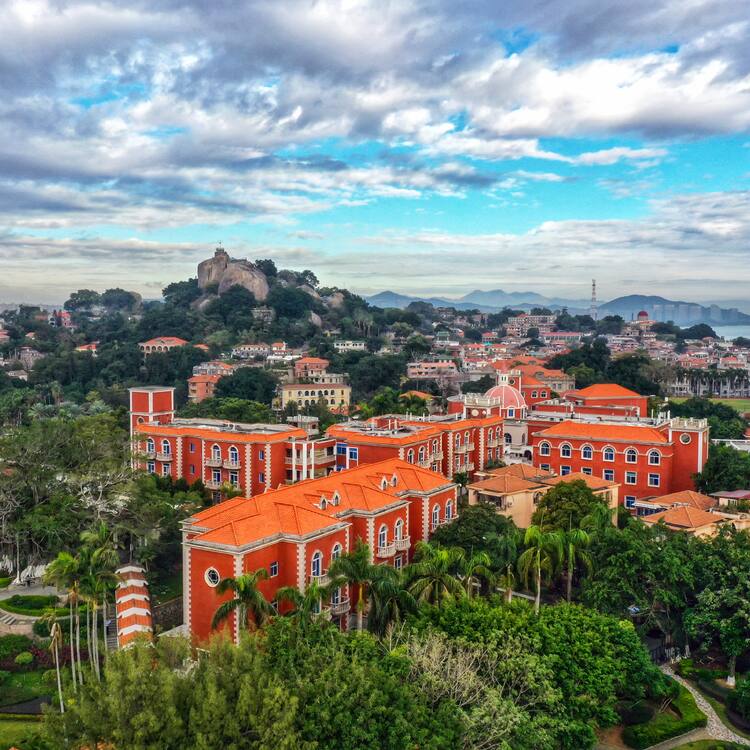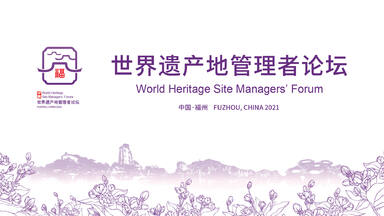Kulangsu, a Historic International Settlement
Kulangsu, a Historic International Settlement
Kulangsu is a tiny island located on the estuary of the Chiu-lung River, facing the city of Xiamen. With the opening of a commercial port at Xiamen in 1843, and the establishment of the island as an international settlement in 1903, this island off the southern coast of the Chinese empire suddenly became an important window for Sino-foreign exchanges. Kulangsu is an exceptional example of the cultural fusion that emerged from these exchanges, which remain legible in its urban fabric. There is a mixture of different architectural styles including Traditional Southern Fujian Style, Western Classical Revival Style and Veranda Colonial Style. The most exceptional testimony of the fusion of various stylistic influences is a new architectural movement, the Amoy Deco Style, which is a synthesis of the Modernist style of the early 20th century and Art Deco.
Description is available under license CC-BY-SA IGO 3.0
Kulangsu, un établissement historique international
Kulangsu est une petite île située dans l’estuaire du fleuve Chiu-lung, à proximité de la ville de Xiamen. Avec l’ouverture de Xiamen comme port de commerce en 1843 et la désignation de Kulangsu comme établissement international en 1903, cette île des côtes sud de l’empire chinois est soudain devenue une importante fenêtre d’échanges sino-étrangers. Kulangsu est un exemple exceptionnel de la fusion culturelle née de ces échanges, qui reste lisible dans son tissu urbain. Différents styles architecturaux s’y mêlent, notamment le style traditionnel du sud du Fujian, le style occidental néo-classique ou le style colonial à véranda. Le témoignage le plus exceptionnel de la fusion des diverses influences stylistiques est un mouvement architectural nouveau : le style Amoy Deco, synthèse entre le style moderniste du début du XXe siècle et le style Art déco.
Description is available under license CC-BY-SA IGO 3.0
Kulangsu: een historische internationale nederzetting
Kulangsu is een piepklein eiland in de monding van de Chiu-lung Rivier, tegenover de stad Xiamen. Toen in die stad in 1843 een commerciële haven opende, en in 1903 Kulangsu een internationale nederzetting kreeg werd dit eiland aan de zuidkust van het Chinese rijk ineens een belangrijke plaats voor Chinees-buitenlandse handel. Kulangsu is een exceptioneel voorbeeld van de fusie van culturen die hiervan het gevolg was. Deze gevolgens zijn nog steeds te zien in het stedelijk weefsel. De stad kent een mix van verschillende architecturale stijlen waaronder de traditionele zuidelijke Fujian stijl, westers klassieke revival stijl en de koloniale veranda stijl. Het meest bijzondere is de fusie van verschillende stilistische invloeden tot een nieuwe architecturale stijl, the Amoy Deco, een versmelting van de Modernistische stijl uit het begin van de 20ste eeuw en Art Deco.
Source: unesco.nl
Outstanding Universal Value
Brief synthesis
Kulangsu Island is located on the estuary of Chiu-lung River facing the city of Xiamen across the 600-meter-wide Lujiang Strait. With the opening of Xiamen as a commercial port in 1843, and Kulangsu as an international settlement in 1903, the island of the southern coastal areas of the Chinese empire suddenly became an important window for Sino-foreign exchanges. Its heritage reflects the composite nature of a modern settlement composed of 931 historical buildings of a variety of local and international architectural styles, natural sceneries, a historic network of roads and historic gardens.
Through the concerted endeavour of local Chinese, returned overseas Chinese, and foreign residents from many countries, Kulangsu developed into an international settlement with outstanding cultural diversity and modern living quality. It also became an ideal dwelling place for the overseas Chinese and elites who were active in East Asia and South-eastern Asia as well as an embodiment of modern habitat concepts of the period between mid-19th and mid-20th century.
Kulangsu is an exceptional example of the cultural fusion, which emerged from these exchanges, which remain legible in an organic urban fabric formed over decades constantly integrating more diverse cultural references. Most exceptional testimony of the fusion of various stylistic influences is a genuinely new architectural movement the Amoy Deco Style, which emerged from the island.
Criterion (ii): Kulangsu Island exhibits in its architectural features and styles the interchange of Chinese, South East Asian and European architectural and cultural values and traditions produced in this variety by foreign residents or returned overseas Chinese who settled on the island. The settlement created did not only mirror the various influences settlers brought with them from their places of origin or previous residence but it synthesized a new hybrid style – the so-called Amoy Deco Style, which developed in Kulangsu and exerted influences over a far wider region in South-east Asian coastal areas and beyond. In this, the settlement illustrates the encounters, interactions and fusion of diverse values during an early Asian globalization stage.
Criterion (iv): Kulangsu is the origin and best representation of the Amoy Deco Style. Named after Xiamen’s local Hokkien dialect name Amoy, Amoy Deco Style refers to an architectural style and typology, which first occurred in Kulangsu and illustrates the fusion of inspirations drawn from local building traditions, early western and in particular modernist influences as well as the southern Fujian Migrant culture. Based on these the Amoy Deco Style shows a transformation of traditional building typology towards new forms, which were later referenced throughout South-East Asia and became popular in the wider region.
Integrity
The integrity of the historic landscape has been maintained, primarily as result of consistent conservation of historic architectural structures and effective development controls regarding height, volume and form of new buildings. The historic relationship of built up and green spaces also contributes to the overall landscape integrity which includes the preserved natural sceneries of cliffs and rocks and the historic gardens, both affiliated courtyard and independent private gardens.
The completeness of the property is demonstrated in the delimitation of the entire island including its surrounding coastal water until the edge of the reef, which underpins that the built structures and the natural setting of the island form one harmonious whole. The early recognition of the harmony has prevented extensive development in the waters surrounding the island, which can be witnesses on other islands or the nearby mainland. Essential for the recognition of the value of the island is that it was never connected to Xiamen via traffic infrastructure and remains solely accessible by ferry. Today, this restriction constitutes and essential element of visitor management processes ensuring the continued intactness of the island.
Tourism pressures are a concern that could affect the integrity of the island and hence require strict controls. A maximum number of 35,000 visitors per day will be allowed to access Kulangsu, a number that will require close monitoring to ensure it suffices to prevent negative impacts of large visitor flows.
Authenticity
Kulangsu Island has retained its authenticity in form and design, location and setting and in many elements of the island material and substance as well as – to a lower extent – use and function. Both the urban settlement patterns as well as the architectural structures have retain their characteristic layout and stylistic features. The latter remain credible representations of the various architectural styles the island unites as well as the Amoy Deco Style it created.
Kulangsu retains its original location and natural landscape setting and has preserved the atmospheric qualities of an ideal residential settlement with a wide range of public services, which continue to serve their original function. The urban structures retain protected by the original legal context, which was created for the establishment of the international settlement in 1903 and remains valid until present. The various spatial contexts of the island, both natural and built-up retain their original links and relations including road connections and sight relations.
Protection and management requirements
Kulangsu was recognized by the State Council as a National Scenic Area in 1988 under the National Scenic Area framework. Fifty-one representative historic buildings, gardens, structures and cultural sites are included in Heritage lists: nineteen as National Heritage Sites, eight as Provincial Heritage Sites, and twenty-four as County Heritage Sites. Moreover, all the provincial and county protected sites will be added to the 8th Tranche of the National Heritage List.
The Conservation and Management Plan for Kulangsu Cultural Heritage was officially adopted 2011 and is being implemented by the Government since 2014. The plan establishes management strategies and actions based on an extensive analysis of the property’s conditions and threats. The strategic documents also integrate the provisions of all other plans and protective regulations into a comprehensive management system institutionalizing the cooperation between all concerned management stakeholders. Indicated as a necessity, the Conservation and Management Plan is supported by Guidelines on Control of Commercial Activities on Kulangsu, which have been adopted in 2014. These guide scale and quality assurance measures for commercial services on the island, in particular those in the tourism sector.
Following the 2017 Capacity Calculation Report of Kulangsu Scenic Zone, the optimum number of people on the island is set at 25,000 while the absolute maximum lies at 50,000 people per day. Since this number includes the residents and commuters to the island, the effective maximum number of visitors in now controlled at 35,000 visitors, including on peak days.


